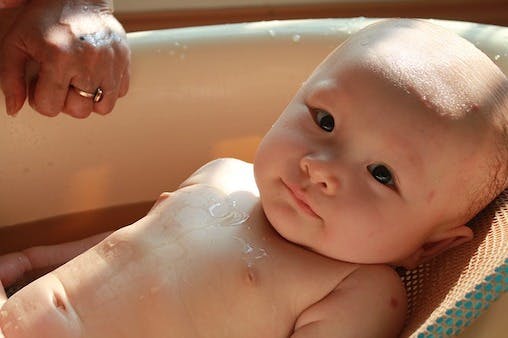Bath Time Fears

Question
My baby is terrified of taking a bath. We use a soft-sided, smaller tub within the big tub with warm water. He screams and cries the entire time. If he sees the water before we put him in the tub, his little body even begins to tremble. What can we do?
Dr. Greene's Answer
Most of us have wonderful soft-focused mental pictures of how special bath time can be. A laughing baby in the bath with shampoo piled high on his head joins other classic childhood images such as the grinning baby whose face is smeared with sweet potatoes, or a brand-new toddler taking his first steps with delight.
How disappointing that your son’s bath time has become something that you both dread! Thankfully, even an intense dislike of baths can usually be turned around. From your question it sounds as if you have done a great job with baby-bathing basics, but I will review them first (just in case one of them sparks a good idea for you).
Baby Bath Time Basics
- Use a tub that is comfortable for your baby – most babies like them to be soft (or lined with a towel) and “just right” in size.
- A couple of inches of warm (not hot) water in the tub is plenty. Babies feel both heat and cold more than we do. If you are unsure about the temperature, you can buy an inexpensive bath thermometer that changes color to indicate safe and comfortable heat levels. (Note: If you haven’t already done so, turn down your hot water heater to no higher than 120 degrees Fahrenheit for safety.)
- Babies lose body heat very quickly, so make sure the room is also warm.
- Some babies are a bit frightened of having their clothes taken off and being exposed to the air. Your soothing voice – singing or talking – will help remind him that he is safe.
- Use age-appropriate toys to engage him in the whole experience. At first this might be something as simple as giving him a clean washcloth to suck on or a rattle to hold. Later, plastic cups and bowls make excellent pouring toys.
- Be careful to use safe, gentle, hypo-allergenic, tear-free products to clean your baby’s skin and hair. The Environmental Working Group has a wonderful database, Skin Deep, that allows you to search for products for personal care and cosmetics. You can search by age group (baby), product, ingredient, or company to find the very safest products available.
- Gently wash him with a soft, warm washcloth. Admire his individual parts — all too often we bundle up our babies and never adore those precious feet.
- It’s a good idea to wash a baby’s hair near the end of bath time. This will help prevent him from losing too much body heat. Also, for babies who dislike baths, this is often the toughest part. Most babies dislike getting their eyes wet. If you tip the head back just a bit and work your way from the front to the back, you can avoid getting water in your baby’s eyes.
- Never leave your baby alone in a bath! Not even long enough to pick up the phone or turn off the iron (who has time to iron with a newborn?!). If you want to answer the doorbell, take your son out of the bath, wrap him in a towel, and take him with you. On your way back to the bath, grab a dry towel to use when his bath is complete.
- Wrap him in a warm, dry towel. Then dress your fresh, clean baby.
Most young babies who initially recoil from baths will come to enjoy them eventually. There are two good options that might help right now and also increase his long-term enjoyment: minimize the bath, or maximize the reward.
Minimal baths are sponge baths – there needn’t be a tub at all. If he likes, you can wash one area at a time and put a fresh item of clothing on as soon as an area is washed and dried. He never needs to be all the way undressed. And it isn’t necessary to bathe him daily. As long as you are spot cleaning after spit-ups, and cleaning his diaper area after bowel movements, he shouldn’t need to be bathed more often than every three or four days. Facing a small version of fears is a great way to overcome them without feeling overwhelmed. Minimal exposure is also the way to acquire new tastes.
My favorite solution, though, is to make the bath a family event in a full-size tub. You can get in the tub first, and have someone carefully hand your son to you. You can wash him with a warm hand towel while you hold him close. The reward of the skin-to-skin contact and the warmth of your presence can turn what was terrifying into a joy for both of you.


